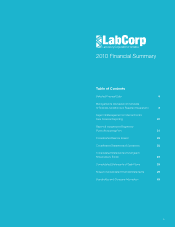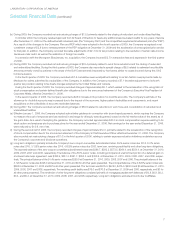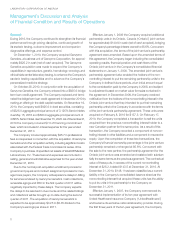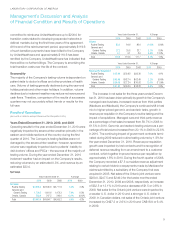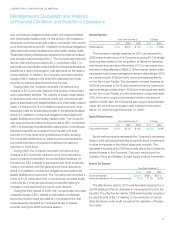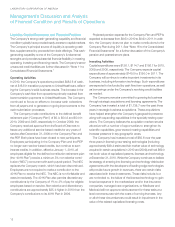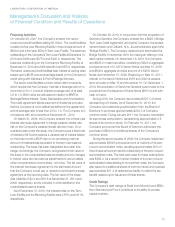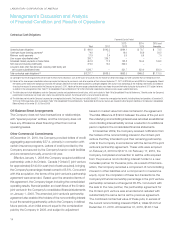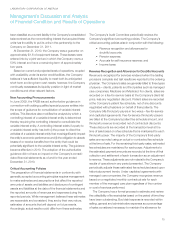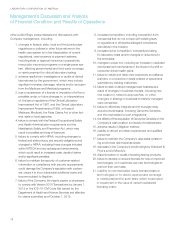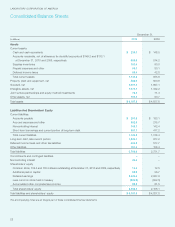LabCorp 2010 Annual Report Download - page 17
Download and view the complete annual report
Please find page 17 of the 2010 LabCorp annual report below. You can navigate through the pages in the report by either clicking on the pages listed below, or by using the keyword search tool below to find specific information within the annual report.15
LABORATORY CORPORATION OF AMERICA
Management’s Discussion and Analysis
of Financial Condition and Results of Operations
been classified as a current liability in the Company’s consolidated
balance sheet as the noncontrolling interest that acquired these
units has the ability to put its units in the partnership to the
Company on December 31, 2011.
At December 31, 2010, the Company was a guarantor on
approximately $1.6 of equipment leases. These leases were
entered into by a joint venture in which the Company owns a
50% interest and have a remaining term of approximately
two years.
Based on current and projected levels of operations, coupled
with availability under its senior credit facilities, the Company
believes it has sufficient liquidity to meet both its anticipated
short-term and long-term cash needs; however, the Company
continually reassesses its liquidity position in light of market
conditions and other relevant factors.
New Accounting Pronouncements
In June 2009, the FASB issued authoritative guidance in
connection with adding qualified special purpose entities into
the scope of guidance for consolidation of variable interest
entities. This literature also modifies the analysis by which a
controlling interest of a variable interest entity is determined
thereby requiring the controlling interest to consolidate the
variable interest entity. A controlling interest exists if a party to
a variable interest entity has both (i) the power to direct the
activities of a variable interest entity that most significantly impact
the entity’s economic performance and (ii) the obligation to absorb
losses of or receive benefits from the entity that could be
potentially significant to the variable interest entity. The guidance
became effective in 2010. The adoption of the authoritative
guidance did not have an impact on the Company’s consoli-
dated financial statements as of and for the year ended
December 31, 2010.
Critical Accounting Policies
The preparation of financial statements in conformity with
generally accepted accounting principles requires management
to make estimates and assumptions that affect the reported
amounts of assets and liabilities and disclosure of contingent
assets and liabilities at the date of the financial statements and
the reported amounts of revenues and expenses during the
reported periods. While management believes these estimates
are reasonable and consistent, they are by their very nature,
estimates of amounts that will depend on future events.
Accordingly, actual results could differ from these estimates.
The Company’s Audit Committee periodically reviews the
Company’s significant accounting policies. The Company’s
critical accounting policies arise in conjunction with the following:
• Revenuerecognitionandallowancesfor
doubtful accounts;
• Pensionexpense;
• Accrualsforselfinsurancereserves;and
• Incometaxes
Revenue Recognition and Allowance for Doubtful Accounts
Revenue is recognized for services rendered when the testing
process is complete and test results are reported to the ordering
physician. The Company’s sales are generally billed to three types
of payers – clients, patients and third parties such as managed
care companies, Medicare and Medicaid. For clients, sales are
recorded on a fee-for-service basis at the Company’s client list
price, less any negotiated discount. Patient sales are recorded
at the Company’s patient fee schedule, net of any discounts
negotiated with physicians on behalf of their patients. The
Company bills third-party payers in two ways – fee-for-service
and capitated agreements. Fee-for-service third-party payers
are billed at the Company’s patient fee schedule amount, and
third-party revenue is recorded net of contractual discounts.
These discounts are recorded at the transaction level at the
time of sale based on a fee schedule that is maintained for each
third-party payer. The majority of the Company’s third-party
sales are recorded using an actual or contracted fee schedule
at the time of sale. For the remaining third-party sales, estimated
fee schedules are maintained for each payer. Adjustments to
the estimated payment amounts are recorded at the time of final
collection and settlement of each transaction as an adjustment
to revenue. These adjustments are not material to the Company’s
results of operations in any period presented. The Company
periodically adjusts these estimated fee schedules based upon
historical payment trends. Under capitated agreements with
managed care companies, the Company recognizes revenue
based on a negotiated monthly contractual rate for each
member of the managed care plan regardless of the number
or cost of services performed.
The Company has a formal process to estimate and review
the collectibility of its receivables based on the period of time they
have been outstanding. Bad debt expense is recorded within
selling, general and administrative expenses as a percentage
of sales considered necessary to maintain the allowance for


